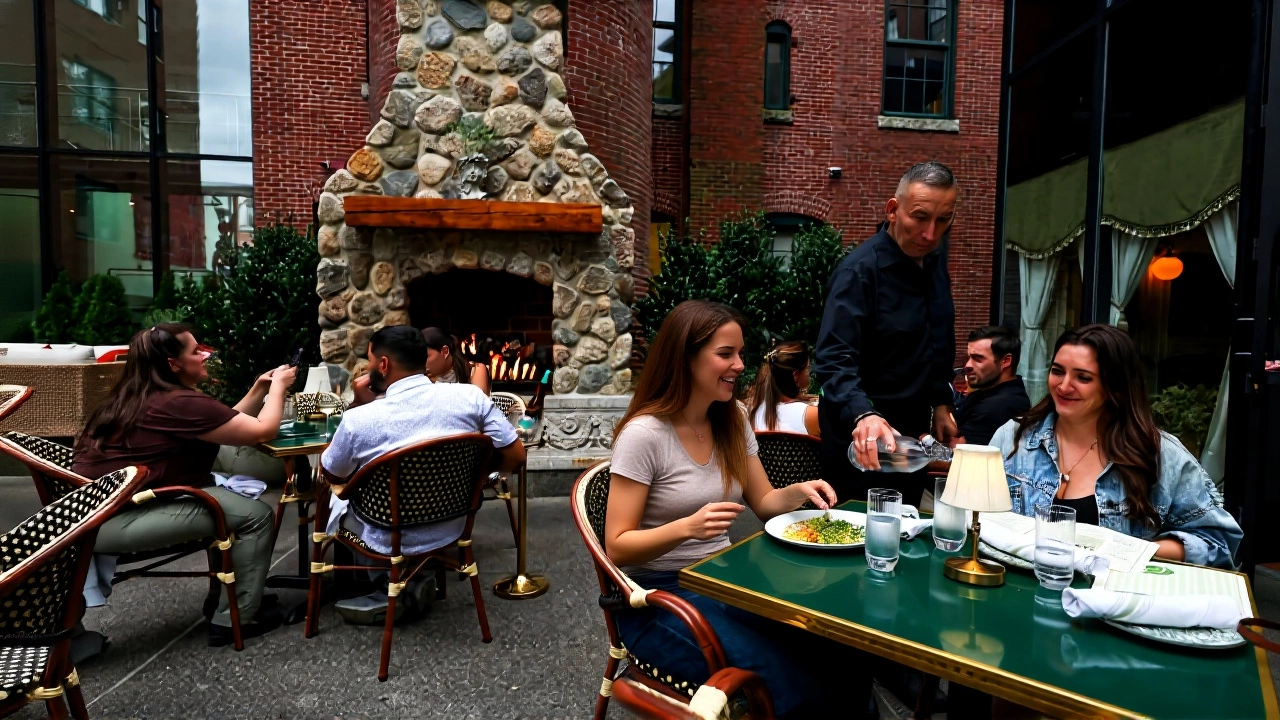For the first time in its 402-year history, Boston has a Michelin-starred restaurant. On November 18, 2025, at 8:00 PM Eastern Standard Time, 311 Omakase, tucked into a quiet South End rowhouse at 311 Harrison Avenue, became the city’s inaugural recipient of the culinary world’s most coveted honor. The announcement came not in Boston, but at the Kimmel Center for the Performing Arts in Philadelphia, during the debut of the 2025 Michelin Guide Northeast CitiesPhiladelphia—a landmark expansion that finally brought Boston, Philadelphia, Chicago, New York City, and Washington, DC under one regional guide. The moment wasn’t just about one restaurant. It was about a city finally being seen.
A Star Born in Silence, Not Noise
"We witnessed and tasted the passion," said Gwendal Poullennec, International Director of the Michelin Guide, during the ceremony. "This isn’t about luxury. It’s about precision, respect for ingredients, and the quiet devotion of a chef who wakes up at 4 a.m. to hand-select fish."That chef is Wei Fa Chen, a Taiwanese-American culinary force with 15 years of omakase training—including seven years spent in Tokyo’s famed Tsukiji fish market. At 311 Omakase, he serves an 18-course tasting menu in a 12-seat counter setting, where each dish is a study in restraint and rarity: Hokkaido uni flown in every 48 hours, Oma bluefin tuna sliced with surgical care, Kagoshima wagyu that melts like butter. The $185 price tag? It’s 22% above Boston’s fine-dining average, but not a single guest leaves unsatisfied. Reservations? You need to book 30 days out on Tock. And you’re lucky if you get one.
What made the difference, according to Michelin’s anonymous inspectors? It wasn’t the décor. It wasn’t the wine list. It was the rhythm. The way the rice is warmed just before serving. The temperature of the dashi. The way the uni is placed on the tongue like a secret.
Boston’s Quiet Rise: The 12-Year Campaign
This star didn’t appear out of nowhere. It was the culmination of a 12-year, $3 million campaign by the Greater Boston Convention & Visitors Bureau. Since 2013, they’ve quietly hosted anonymous Michelin inspectors—covering meals, lodging, transportation—all to prove Boston wasn’t just clam chowder and baked beans. They hosted pop-ups, funded chef exchanges, even flew in Japanese seafood suppliers to demonstrate sourcing rigor."We didn’t beg," says Devra First, editor-in-chief of Boston Chefs. "We showed up. We had the best. We let the food speak. And Michelin listened."
Now, the payoff is real. Industry analysts project a 35% surge in tourism dining revenue for Boston’s high-end restaurants in 2026—roughly $12.7 million in additional spending, mirroring New York City’s post-2006 boom. Hotels near the South End are already reporting 40% higher occupancy for weekend stays in December. One local Airbnb host, who rents a unit two blocks from 311 Omakase, says she’s turned away 17 reservation inquiries in the past week.

The Full Picture: Bib Gourmands and the New "Recommended" Tier
The Michelin Guide didn’t just spotlight one restaurant—it elevated Boston’s entire dining ecosystem. Alongside the star, six restaurants earned the Bib Gourmand designation: meals of exceptional quality under $40. That includes:- Bar Volpe (247 Shawmut Ave): $16 handmade pasta
- Sumiao Hunan Kitchen (250 Massachusetts Ave): $14 dry-pot specialties
- Fox & the Knife (1200 Washington St): Butchered, grilled, and smoked with precision
- Jahunger (55 Temple Pl): Korean-Japanese fusion that defies category
- Mahaniyom (15 Beach St): Thai comfort food with a chef’s touch
- PAGU (371 Columbus Ave): Creative, seasonal, and unpretentious
And for the first time ever, Michelin introduced a "Recommended" tier—restaurants serving "consistently good food" at accessible prices. Boston’s list includes Asta (1369 Boylston St) with its $45 tasting menu, and Carmelina’s (1079 Commonwealth Ave), where Sunday gravy is still served with a side of family tradition.
"This isn’t a hierarchy," says Poullennec. "It’s a map. A map of where people are eating well, no matter the price."

What’s Next? Worcester, Multi-Star Dreams, and the New Normal
Michelin’s regional inspector team lead hinted during the post-ceremony press scrum that Worcester, Massachusetts could join the 2027 Northeast Cities guide. "There’s momentum," the inspector said. "We saw three restaurants in Worcester that could be Bib Gourmand candidates next year."As for 311 Omakase? A second star is possible—but not before November 2026. Michelin’s rules demand at least 12 months between inspections. Chen says he’s not chasing stars. "I’m chasing the next piece of fish," he told reporters after the ceremony. "If the star comes, it’s a gift. If it doesn’t, I’ll still be here at 4 a.m."
Meanwhile, the Michelin Guide’s website published the full 2025 Northeast Cities list at 12:01 AM EST on November 19, 2025. Boston’s 26 listed restaurants make up 3.9% of the region’s 664 total—proof that size doesn’t matter. Quality does.
Frequently Asked Questions
How does this affect Boston’s dining scene beyond 311 Omakase?
The Michelin star has already triggered a ripple effect: hotel bookings near the South End are up 40%, and local chefs report a 50% spike in reservations at other fine-dining spots. The Bib Gourmand and Recommended listings have given smaller restaurants new visibility, with some reporting 30% more walk-ins. Boston’s culinary identity is shifting from "historic" to "world-class," attracting not just tourists but culinary talent from across the country.
Why was the announcement held in Philadelphia, not Boston?
The Michelin Guide rotates its regional launch locations for logistical and symbolic reasons. Philadelphia was chosen as the inaugural Northeast Cities host to highlight the region’s interconnected culinary culture. It also reflects Michelin’s strategy of treating the Northeast as a unified gastronomic zone—not a collection of isolated cities. Boston’s lack of a major convention center made Philadelphia the practical choice, despite the symbolic weight.
What makes 311 Omakase different from other Japanese restaurants in Boston?
Unlike most omakase spots that import ingredients weekly, 311 Omakase flies in premium seafood from Japan every 48 hours via Logan International Airport, ensuring peak freshness. Chef Chen’s training in Tsukiji gives him direct relationships with fishermen and auction houses. His 18-course menu changes daily based on catch, season, and even weather patterns—something Michelin inspectors called "uniquely Japanese in its reverence." No other Boston restaurant operates this way.
Can I still get a reservation at 311 Omakase?
Reservations open exactly 30 days in advance via Tock, and they vanish within minutes. As of November 20, 2025, the next available table is January 15, 2026. Waitlists are closed. Some guests are paying third-party brokers up to $1,000 for a seat—a practice Michelin discourages. Your best bet? Set a reminder for 12:01 AM EST on the 15th of each month and refresh promptly.
What’s the significance of the Bib Gourmand and Recommended designations?
The Bib Gourmand isn’t just a discount label—it’s a seal of culinary integrity for affordable dining. Michelin inspectors evaluate these restaurants the same way they do stars: consistency, technique, ingredient quality. Recommended status is even more nuanced—it’s for places that don’t quite reach Bib level but still serve food you’d return to. Together, they prove Boston’s food culture isn’t just elite—it’s deeply rooted, diverse, and accessible.
Will Worcester get included in next year’s guide?
While not official, Michelin’s regional inspector team confirmed during the November 18 press briefing that Worcester is under active review. Three restaurants there—The Kitchen at the Worcester Art Museum, Bistro 22, and Saffron Spice—are known to have received multiple anonymous visits. A 2027 inclusion is plausible, especially if those spots maintain their standards. The city’s growing artisanal food scene, from craft breweries to heritage grain bakeries, makes it a natural extension of the Northeast culinary corridor.
